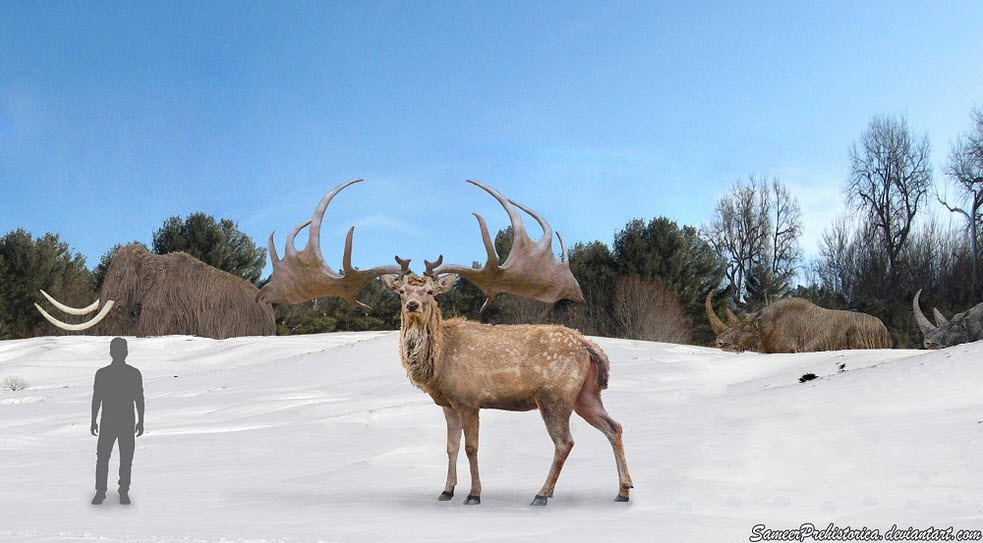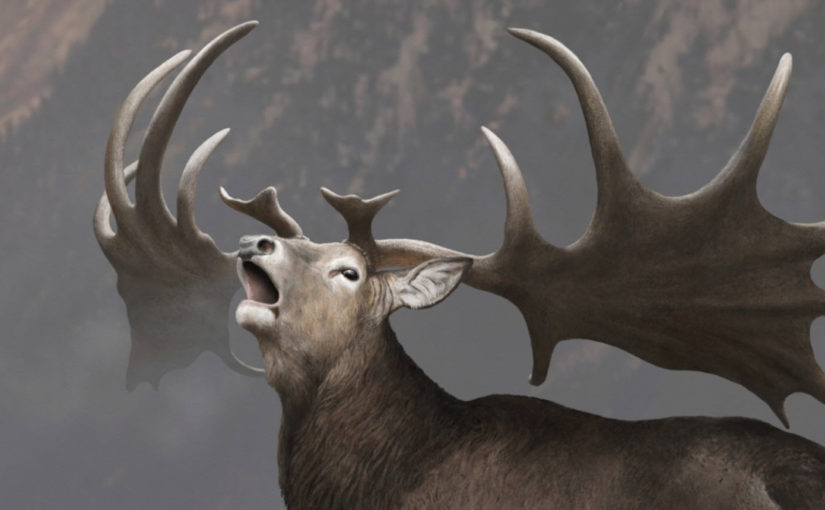Quick Megaloceros Facts
- Lived from the Pleistocene through the Modern Period
- Lived on the plains of Eurasia
- Was as long as an elk
- Weighed as much as 10 white-tailed deer
- Was an herbivore
- Its antlers were longer than a car
About Megaloceros
Megaloceros, also known as the Irish Elk, was a genus of deer which lived approximately 2 million to 10,000 years ago – from the Pleistocene through the Modern Period. It was first discovered during the late 18th century and was named by Johann Friedrich Blumenbach in 1799. Its name means “giant horn.”
The genus of Megaloceros covers 9 distinct species of this genus, but only one of them were as large as small dinosaurs. And that species is Megaloceros giganteus. It is also the one that we will be talking about today.

If you look at Megaloceros pictures, then you’ll quickly realize that this animal looks like an elk with an extremely large set of horns. However, that is not entirely accurate. These mammals had more in common with North American deer than it did with European elks. Another one of the interesting facts about Megaloceros is that it wasn’t exclusive to Ireland either. This deer lived all over Eurasia.
This animal was approximately 8 feet long and weighed around 1,500 pounds. Which is about the length of a modern elk but nearly double the weight of one. Another feature that made it quite different from looking like a modern elk is its antlers. Its antlers were about 12 feet long and weighed around 100 pounds.
As impressive as that sounds, their antlers weren’t used for combat, however. They were almost certainly used by the male deer to attract females.
Megaloceros went extinct right at the cusp of the last Ice Age. And scientists aren’t exactly sure why.
Some paleontologists have speculated that overpopulation and inbreeding led to a population of Megaloceros’s that were unable to adapt when the climate changed. Other paleontologists believe that mankind hunted them into extinction. Most likely, it was a combination of these two facts which led to the inevitable demise of these majestic looking animals.
Speaking about some large racks…
Of course, I just couldn’t help myself. Heh heh.

Here’s the videos. Most are under thirty seconds. Very quick. To open them up, just click on the link below.
- MOV1 – She’s from Hunan, and I love her in traditional clothes.
- MOV2 – She’s a mighty big girl.
- MOV3 – She’s a clothing model.
- MOV4 – It’s hard to concentrate on her trousers.
- MOV5 – I do like her top.
- MOV6 – Demure, but impressive.
- MOV7 – Damn!
- MOV8 – This is a really nice girl.
- MOV9 – One of my favorites.
- MOV10 – She always puts a smile on my face.
And a second group…

- 1mov1
- 1mov2 – Hello There!
- 1mov3
- 1mov4 – She has some beautiful children.
- 1mov5
- 1mov6
- 1mov7 – This raises my cockles.
- 1mov8 – Great googily moogily
- 1mov9
- 1mov10
Now wasn’t that fun? Yeah. I like looking at pretty girls.
And the point that I am trying to make is… um… well, big physical attributes tell us nothing about the person who displays them. But they DO tend to get our attention.
I posit that the Megaloceros evolved with these large enormous horns not because it offered it better ability to forage, to run, to camouflage or to survive, but rather to attract the attention of females that wouldn’t help but notice his enormous, gigantic presence.
Instead of survival, it was procreation of the species.
Which is a very important driving force for life. And while it might not be all that progressively popular to admit, it is true. Species that are not able to procreate to the point where it is able to live within it’s environment are doomed for extinction.
Perhaps we see that manifesting in humans as well. Eh?
It does make you wonder about the LGBT movement…
Do you want more?
I have more posts in my Happiness Index here…
Life & Happiness.
Articles & Links
Master Index.
You’ll not find any big banners or popups here talking about cookies and privacy notices. There are no ads on this site (aside from the hosting ads – a necessary evil). Functionally and fundamentally, I just don’t make money off of this blog. It is NOT monetized. Finally, I don’t track you because I just don’t care to.
- You can start reading the articles by going HERE.
- You can visit the Index Page HERE to explore by article subject.
- You can also ask the author some questions. You can go HERE to find out how to go about this.
- You can find out more about the author HERE.
- If you have concerns or complaints, you can go HERE.
- If you want to make a donation, you can go HERE.
Please kindly help me out in this effort. There is a lot of effort that goes into this disclosure. I could use all the financial support that anyone could provide. Thank you.
.



Thank you, MM. That just took my stress level back down to manageable levels. Really, it did.